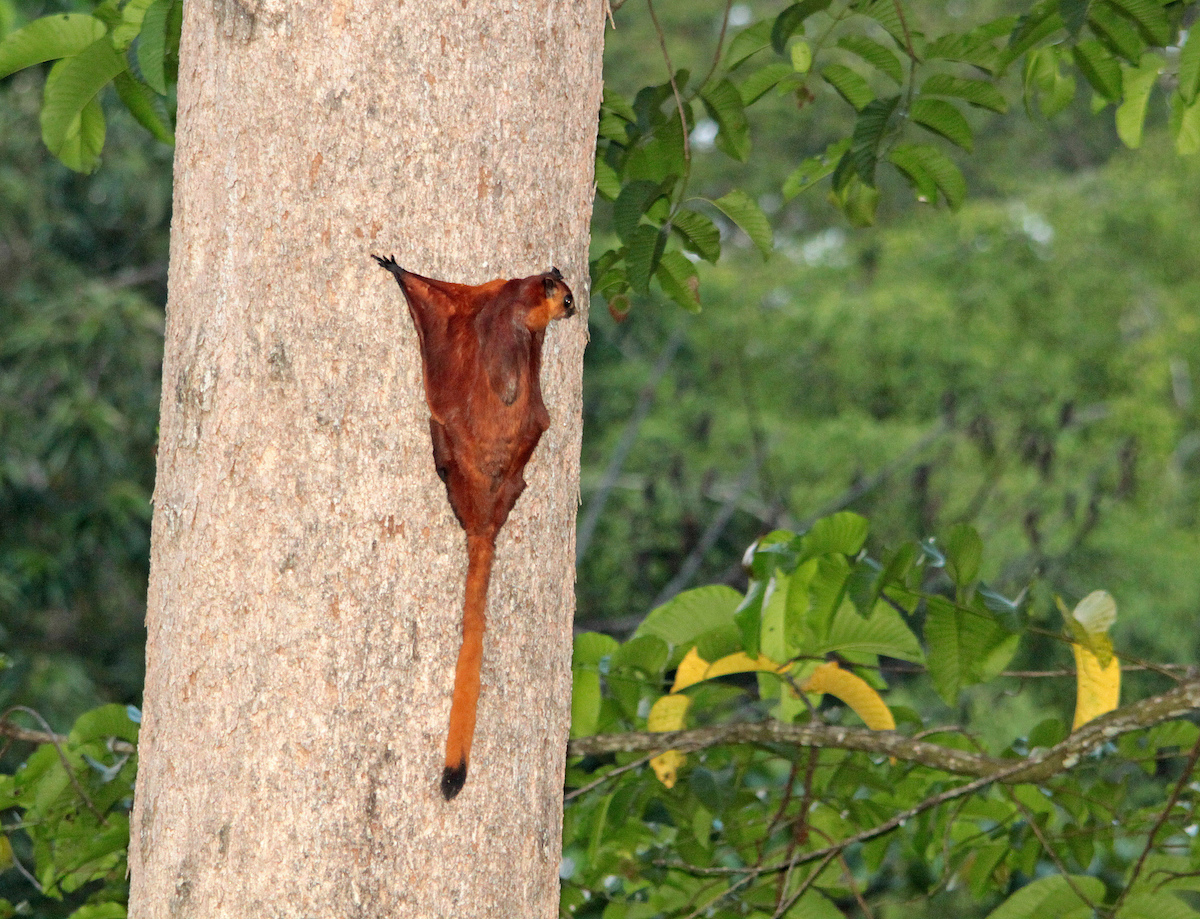 Evolution & Behaviour
Evolution & Behaviour
Gliding mammals during the Age of Dinosaurs
Tiny mammals lived amongst the dinosaurs for over 100 million years; probably often trying not to be stepped on or eaten by the giant beasts. What did these little creatures look like, and how did they cope with their surrounding environment?

There is a tremendous interest in the dinosaurs that ruled the Earth during the Mesozoic Era, or the Age of Dinosaurs, but what about our mammalian ancestors that were alive at the same time? Tiny mammals lived amongst the dinosaurs for over 100 million years; probably often trying not to be stepped on or eaten by the giant beasts. These mammals have traditionally been described as small (about mouse-sized) insect-eaters who were active at night. In other words, they were typically thought of as being fairly dull or nondescript.
However, recent fossil discoveries have shown that mammals during the Age of Dinosaurs were much more diverse than previously thought. For example, we now know that some of the early mammals were gliders, similar to modern flying squirrels. I was one of several authors on two recent papers that describe new fossil gliders from China. The fossils are spectacular - they include entire skeletons, as well as the delicate remnants of skin-flap wings that allowed the mammals to glide from tree to tree. The fossils represent extinct species that lived 160 million years ago during the Jurassic Period. For reference, dinosaurs (except birds) went extinct due to a meteorite impact about 66 million years ago. In other words, these mammal fossils are really, really old.
Throughout their evolutionary history, mammals have evolved many different lifestyles, and each lifestyle includes bodies that make sense for that lifestyle. There are bats with wings for flight, dolphins with flippers for swimming, and horses with long legs for running. Gliding is one lifestyle that actually evolved multiple times in different mammal groups. Alive today are several groups of gliders, including flying squirrels, sugar gliders, and flying lemurs (which aren't actually lemurs but look like them). And each of these groups are not closely related. That is, they each evolved the gliding behavior independently. The extinct fossils that we described also evolved independently (they are not closely related to any modern gliders), and may be the oldest known mammalian gliders. This makes these fossil specimens especially unique discoveries.
For our publications on the gliding mammals, we accomplished three major tasks. First, we described the new fossils in detail. This included producing images of the fossils through computed tomography (CT) scans, which are equivalent to "CAT scans" at hospitals and can be thought of as powerful, 3D X-rays. This allowed us to see parts of the fossil that are otherwise hidden by the attached rock. Additionally, the scans allow us to see inside the bones at internal parts of the skeleton, like roots of the teeth. Our detailed examination of the fossils is important because it helps us determine the evolutionary relationship between the new species and other mammals.
Second, we examined the jaws and teeth of the fossils to try to figure out what foods they ate. Tooth shapes can offer a lot of clues - sharp teeth are better for meat and insects, and flat teeth are good for eating plants. The fossils have teeth that are similar to the flat or knobby teeth of modern seed eaters, so we believe they ate plant material like seeds. This information is important for deciphering their ecological role in the environment.
Third, we examined the limb bones of the fossils to see if they are similar to those of other gliders. Modern gliders have very long, slender limbs that allow the attached skin flaps (wings) to expand out for gliding. We took measurements of the fossils and found that they also have very long, slender limb bones. This provided us with even stronger evidence that these extinct mammals were gliders. We also discovered something unexpected from these measurements: the mammals probably hung from branches (or roosted) when resting, similar to bats that hang upside down from their feet when they're not flying. No other early mammals are known to have roosted, which makes this an especially exciting discovery.
This project contributes to our improved understanding of the early history and diversity of mammals. Based on our studies and other recent fossil discoveries, we now know that not all mammals during the Age of Dinosaurs were scurrying around the forest floors avoiding dinosaurs - some were hanging out in forests and gliding from tree to tree. It turns out that our early ancestors were a bit cooler than originally thought.
Original Article:
Q.-J. Meng et al., New gliding mammaliaforms from the Jurassic. Nature 548, 291 (2017).Edited by:
Massimo Caine , Founder and Director
We thought you might like
The puzzling history of South American mammals
Nov 17, 2021 in Evolution & Behaviour | 3.5 min read by Juan D. CarrilloMore from Evolution & Behaviour
Cicada emergence alters forest food webs
Jan 31, 2025 in Evolution & Behaviour | 3.5 min read by Martha Weiss , John LillSize does not matter: direct estimations of mutation rates in baleen whales
Jan 29, 2025 in Evolution & Behaviour | 4 min read by Marcos Suárez-MenéndezThe Claws and the Spear: New Evidence of Neanderthal-Cave Lion Interactions
Jan 22, 2025 in Evolution & Behaviour | 3.5 min read by Gabriele RussoA deep-sea spa: the key to the pearl octopus’ success
Jan 20, 2025 in Evolution & Behaviour | 3.5 min read by Jim BarryFeisty fish and birds with attitude: Why does evolution not lead to identical individuals?
Aug 31, 2024 in Evolution & Behaviour | 3 min read by Lukas Eigentler , Klaus Reinhold , David KikuchiEditor's picks
Trending now
Popular topics


